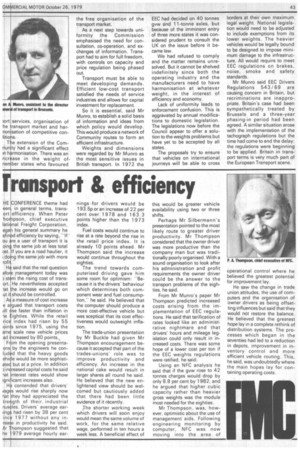ransport IL efficiency
Page 45

If you've noticed an error in this article please click here to report it so we can fix it.
HE CONFERENCE theme had een in general terms, transort efficiency. When Peter ho pson, chief executive lati nal Freight Corporation, ega his general summary he efin d efficiency by saying, "If ou re a user of transport it is oinl the same job at less total ost. If you are a road haulier, it ; do ng the same job with more rot ii."
H said that the real question efo management today was 3 St m the rising cost of transort. He nevertheless accepted at he increase would go on ut i should be controlled.
Ad a measure of cost increase e a gued that transport costs iill rise faster than inflation in ie Eighties. While the retail rice index had risen by 55 loints since 1975, using the am scale new vehicle prices ad icreased by 80 points.., F m the opening presentaonsi by the engineers he conlud d that the heavy goods ehi le would be more sophistiate but at a price. In addition 3 in reased capital costs he said nat interest rates would show igni icant increases also.
H contended that drivers' vag s would rise sharply now hat hey had appreciated the tre gth of their, industrial nus les. Drivers' average carting had risen by 38 per cent inc 0 1977 without any inrea e in productivity he said. i1r hompson suggested that he 979 average hourly ear nings for drivers would be 193.5p or an increase of 22 per cent over 1978 and 163.3 points higher than the 1973 index.
Fuel costs would continue to rise at a rate beyond the rise in the retail price index. It is already 10 points ahead. Mr Thompson said the increase would continue throughout the eighties.
The trend towards computerised driving gave him some room. for optimism: "Because it is the drivers' behaviour which determines both component wear and fuel consumption," he said. He believed that the computer should produce a more cost-effective vehicle but was sceptical that its cost effectiveness would outweight inflation.
The trade-union presentation by Mr Buckle had given Mr Thompson encouragement because it accepted that part of the trades-unions' role was to improve productivity and efficiency. An increase in the national cake would result in larger shares all round he said. He believed that the new enlightened view should be welcomed but cautiously added that there had been little evidence of it recently.
The shorter working week 'which drivers will soon enjoy would mean the same volume of work, for the same relative wage, performed in ten hours a week less. A beneficial effect of this would be greater vehicle availability using two or three shifts.
Perhaps Mr Silbermann's presentation pointed to the most likely route to greater driver productivity. Mr Thompson considered that the owner driver was more productive than the company man but was traditionally poorly organised. With a sound organisation to look after his administration and profit requirements the owner driver could be the answer to the transport problems of the eighties, he said.
From Mr Munro's paper Mr Thompson predicted increased costs arising from the implementation of EEC regulations. He said that tarification of rates looked like an administrative nightmare and that drivers' hours and mileage legislation could only result in increased costs. There was some hope of a lower cost per ton if the EEC weights regulations were ratified, he said, Using an NFC analysis he said that if the gvw rose to 42 tonnes charges would drop by only 8.8 per cent by 1982. and he argued that higher cubic capacity rather than heavier gross weights was the module most needed for the eighties.
Mr Thompson, was, however, optimistic about the use of management aids, Following engineering monitoring by computer, NFC was now moving into the area of operational control where he believed the greatest potential for improvement lay.
He saw the change in trade union attitudes, the use of computers and the organisation of owner drivers as being offsetting influences but said that they would not restore the balance. He believed that the greatest hope lay in a complete rethink of distribution systems. The processes which began in the seventies had led to a reduction in depots, improvement in inventory control and more efficient vehicle routing. This, he said, was undoubtedly where the main hopes lay for containing operating costs.
























































































































